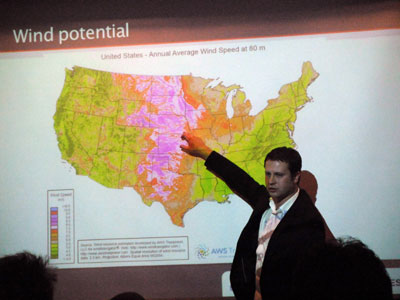Graduate students gathered Tuesday evening in the Engineering Hall to hear an presentation by Mines’ very own Professor Daniel T. Kaffine. An Assistant Professor of Economics and Business, Professor Kaffine reported to his audience on the emission savings from wind power generation in the United States through a revolutionary new method.
Wind power is the most rapidly growing renewable energy source in the United States. It currently provides the US with 2% of its power, while saving the environment from the harmful effects of other sources. According to Kaffine, and research gathered from three of the largest operation facilities in America, 2009 emissions savings in the United States “totaled 15.9 million pounds of SO2, 77 million pounds of NOX, [and] 43 million tons of CO2.” Research from CAISO, MISO, and ERCOT, three major US power producers, revealed the areas with the most potential for wind power success. Unsurprisingly, Kansas, Nebraska, and Wyoming top the list of states. Then, using cost-benefit analysis, Kaffine attempts to answer the question of whether “the environmental benefits cover the Federal Production Tax Credit of $22/MWh.”
Power generated from the wind increases as wind speed increases. For example, if the wind speed doubled, the power produced would increase by a power of eight. However, as more wind power is put onto the power grid, some power must be taken off at another location. Measuring this displaced generation is determined by two variables. The unit of accommodation addresses what comes off the grid when wind power is put on; the emissions rate tackles how much the cost is being reduced by this process.
Kaffine and his coauthors, Brannin McBee and Jozef Lieskovsky, analyzed three different methods for measuring the emission savings from wind power use. The first two methods include using either the average unit of accommodation or the average emissions rate. Kaffine states that neither of these methods is very realistic because both can overstate the savings. Natural gas can often bias results, as it is the most expensive and thus the most commonly reduced. “Our approach,” Kaffine explains, “is more flexible and less prone to bias.” This method incorporates the marginal unit of accommodation and the marginal emissions rate, rather than the averages of each, to give precise results.
Through over 50,000 observations, Kaffine exposed that only his analysis of MISO’s results for environmental benefits justifies government subsidies at about $20/MWh. The results for CAISO top the chart at more than $70/MWh. ERCOT’s emissions rates come in at about $45/MWh, more than twice what the government has allotted to wind power generation. In other areas, “we are paying $1.5 million and only getting $1 million in return through emissions avoided.”
Kaffine notes that his research is only based on two-thirds of wind power generation in the United States, and does not imply an appreciation for or against wind power. “We are attempting to estimate the other one-third,” he adds, “through this new method.” Kaffine, McBee, and Lieskovsky look forward to publishing their research in the near future.



'Emission savings from wind power generation' has no comments
Be the first to comment this post!